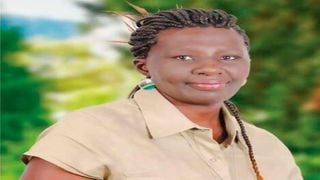
Ms Sabenzia Killong who died at Kenyatta National Hospital. She was buried at Lang'ata Cemetery as her family desperately looked for her.
| PoolNews
Premium
Body of woman secretly buried by KNH found with no legs
What you need to know:
- The exhumation followed an order issued on Monday by the Milimani Law Courts.
The missing legs have left the family wondering what could have happened after Sabenzia’s death.
An autopsy report has revealed that the body of a woman that Kenyatta National Hospital hurriedly buried had both legs cut off before interment.
The findings released by Government Pathologist Johansen Oduor indicated both legs had been severed from the body of Sabenzia Killong, which was exhumed on Thursday morning from a mass grave at the Lang’ata cemetery.
The exhumation followed an order issued on Monday by Principal Magistrate J.D.M Kivuti at the Milimani Law Courts and witnessed by a court officer and police officers from Lang’ata Police Station.
“The right leg had been severed from the tibia (below the knee) and the left leg from the femur (mid hip). All the internal body organs were present. However, the body was fairly decomposed and as such, we cannot immediately establish the cause of her death. We shall, however, expose the sample to further microscopic analysis,” said Dr Oduor.
He explained that he had obtained samples for histology and toxicology tests.
“We do the histology test to find out whether the body tissues are normal or not, and the toxicology tests to find out if the body has chemical toxins. We shall take into consideration the medicines she used, and we’ll release the results when they are ready,” stated Dr Oduor, adding that the body was ready to be released for burial.
He added that for definitive identification, a DNA test would have to be done.
Missing legs
“We have collected cartridges, a tooth and nails to be used in the DNA test. For purposes of efficiency, we will need to take samples from the mother, so we have to wait until she has healed and is able to travel,” said the pathologist.
According to Monicah Killong, a sister of the deceased, all the other bodies in the grave were intact and had identification tags on their legs.
However, she said her sister’s tag hung on her wrist and that upon exhumation they could not find the missing legs.
“We want to assume that the reason our sister’s body had a tag on the wrist is that she had no feet that they could attach the tag to. Her discharge summary did not reveal anything about her body being incomplete,” said Monicah.
Monicah, a nurse by profession, explained that a tag is attached to a body immediately after death and before it is taken to a morgue for preservation.
“The common identifiers are the name, date of birth and registration number. Once a person dies, the tag can include the identification number. We do the tagging before releasing the body to the morgue, so we are assuming that the body was released from the hospital already amputated,” she explained.
The missing legs have left the family wondering what could have happened after Sabenzia’s death.
Decent send off
“The men who were helping us exhume the bodies said my sister’s was mutilated at the time of burial. We know she walked to the hospital to seek treatment, so who cut her legs off?” she posed.
The family was, however, happy that they could finally give their loved one a decent send off.
“When we came to Nairobi to follow up on this case, we did not know that we would find her. We kept telling other family members to put off the burial preparations a little longer. We had faith, and we had even purchased a coffin. Now we can take Sabenzia home and lay her to rest,” said Ms Redempta Wekesa, an aunt of the deceased.
She said they were sure that the body was her niece’s, as they had even confirmed her dental formula and the hairstyle she wore at the time of her death.
“On the day Sabenzia disappeared, she had asked her neighbour to help her undo her hair when she got back home. She still has the same hairstyle she had in her last picture,” added Ms Wekesa.
Sabenzia went missing on December 24, 2020.
The family got worried when she failed to send her Christmas and New Year messages of goodwill.
Daughter’s disappearance
A search was launched, posters printed and posted and a missing person’s report filed at different police stations.
Early this year, Sabenzia’s mother escalated the matter of her daughter’s disappearance to the Serious Crime Unit at the Directorate of Criminal Investigations (DCI).
DCI officers traced Sabenzia’s phone to a woman who later said they had been admitted at the same time to KNH.
“At first, the hospital denied ever having a patient that went by my sister’s name. When the DCI approached them, the hospital told the officers to do an official inquest. That was on April 26.
The next day, the hospital buried my sister, then on April 28, they responded to the DCI, saying they had admitted my sister and that she had died and was already buried,” said Monicah.
Now with the autopsy results out, the question ringing in the family members’ minds is: Who cut Sabenzia’s legs and why? And was this the reason for the hurried burial?
Sabenzia will be laid to rest on Saturday, May 29 at her ancestral home in Tongaren, Bungoma County.




